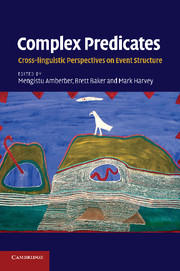Book contents
- Frontmatter
- Contents
- List of figures and tables
- List of contributors
- Preface
- 1 Introduction: complex predicates
- 2 Complex predicate formation
- 3 The light verb jungle: still hacking away
- 4 Events and serial verb constructions
- 5 Cotemporal serial verb constructions in White Hmong
- 6 Activity incorporates in some Athabaskan languages
- 7 Warlpiri verbs of change and causation: the thematic core
- 8 Complex predicates in Wambaya: detaching predicate composition from syntactic structure
- 9 Compound verbs and ideophones in Wolaitta revisited
- 10 The structure of the light verb construction in Amharic
- Index
9 - Compound verbs and ideophones in Wolaitta revisited
Published online by Cambridge University Press: 07 May 2010
- Frontmatter
- Contents
- List of figures and tables
- List of contributors
- Preface
- 1 Introduction: complex predicates
- 2 Complex predicate formation
- 3 The light verb jungle: still hacking away
- 4 Events and serial verb constructions
- 5 Cotemporal serial verb constructions in White Hmong
- 6 Activity incorporates in some Athabaskan languages
- 7 Warlpiri verbs of change and causation: the thematic core
- 8 Complex predicates in Wambaya: detaching predicate composition from syntactic structure
- 9 Compound verbs and ideophones in Wolaitta revisited
- 10 The structure of the light verb construction in Amharic
- Index
Summary
Introduction: overview of the phenomenon
Complex predicates, subsuming what are known as particle+‘say’ verbs, compound verbs, and ideophonic constructions are widely attested in the Ethiopian Cushitic, Omotic, and Semitic languages. They are reported for Amharic (Leslau 1945, 1995; see also Amberber, this volume), Awngi (Hetzron 1969), Bench (Rapold 2006), Hamar (Lydall 2000), Qafar (Hayward 1994), Somali (Dhoorre and Tosco 1998), and Wolaitta (Adams 1983, Lamberti and Sottile 1997, Amha 2001, Amha and Dimmendaal 2006a, Amha, this volume), among others. Appleyard (2001) and Cohen, Simeone-Senelle and Vanhove (2002) have highlighted the importance of the construction for (historical)-comparative studies of Afroasiatic as it can account for a number of innovations in the verbal system of Cushitic, Omotic, and Semitic languages.
The construction involves two predicative elements, which could be labelled temporarily: P(redicate)1 + P(redicate)2. P1 is often represented by a verbal form with restricted inflectional possibilities, e.g. by the converb (also known as gerundive), ideophonic verb, or a derived verbal stem. In some languages, e.g. Qafar (Central Cushitic), P1 may be a noun, an adjective, or a postpositional phrase (cf. Hayward 1994). P2 is a fully inflecting verb if the complex predicate is the head of a clause.
- Type
- Chapter
- Information
- Complex PredicatesCross-linguistic Perspectives on Event Structure, pp. 259 - 290Publisher: Cambridge University PressPrint publication year: 2010
- 3
- Cited by



